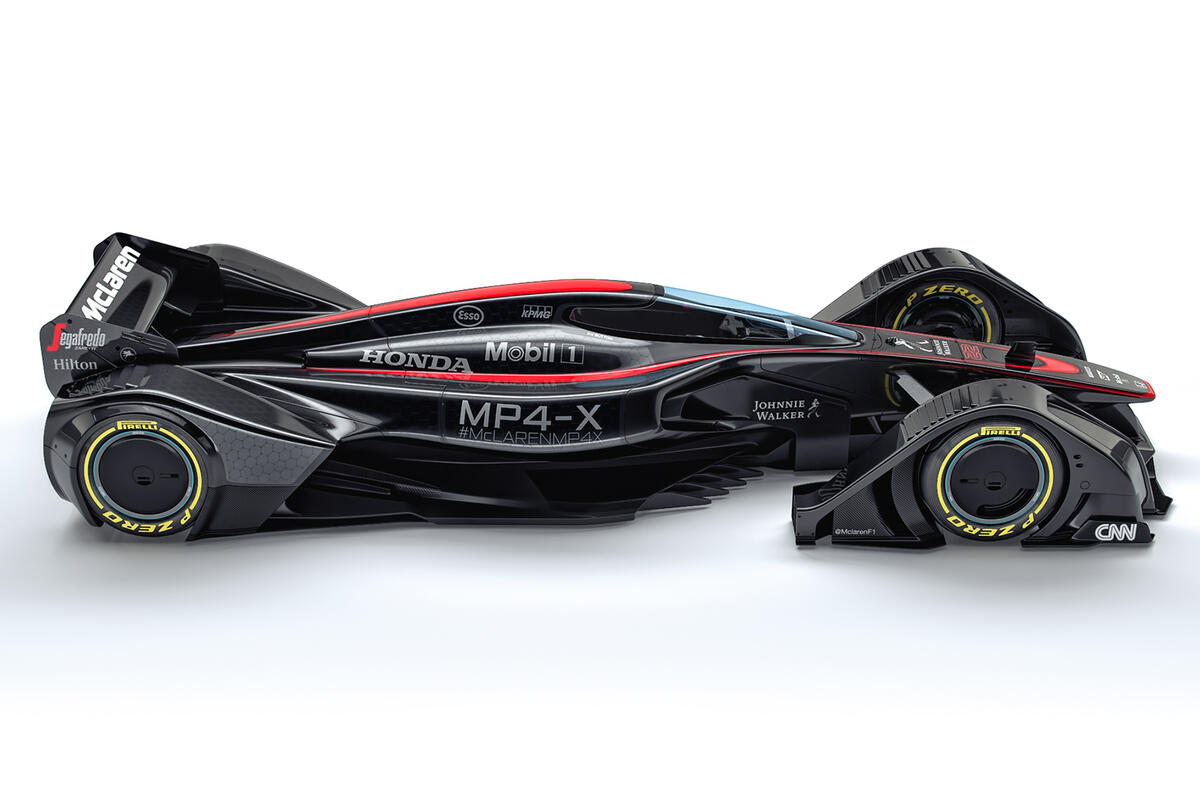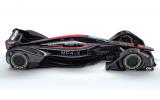McLaren has revealed its interpretation of how Formula 1 cars might look in the future.
The MP4-X single-seat, closed-cockpit racer is predominantly the work of the McLaren Applied Technologies, the arm of McLaren which is involved in producing advanced solutions for a variety of industries including medicine, electronics and energy.
“With the futuristic McLaren MP4-X concept racecar, we wanted to peer into the future and imagine the art of the possible,” said John Allert, group brand director at McLaren Technology Group.
“We have combined a number of F1’s key ingredients – speed, excitement and performance, with the sport’s emerging narratives - such as enclosed cockpits to enhance driver safety, and hybrid power technologies.”
“Formula 1 is the ultimate gladiatorial sport, and the future we envisage will be a high tech, high performance showcase that excites fans like no other sport.”
The technology contained within MP4-X is all real, although many elements are still in the early stages of development and not feasible (or too expensive) for use in today's racing.
Powertrain
The MP4-X doesn’t have an internal combustion engine, instead using electric power, an area the company is already building experience of thanks to the McLaren P1 hypercar and its work in supplying power systems to Formula E.
Rather than storing energy in concentrated areas, McLaren would use ‘thin batteries’ that would be integrated into the vehicle’s crash structure. These would store energy from brake energy regeneration, solar energy capture and inductive charging loops embedded in the track surface.
Solar energy could be used to supplement existing onboard systems, or deployed as a boost option.
Electricity would be stored and distributed within the vehicle’s structure and bodywork, where it would always be close to where it is both generated and used.
Active aerodynamics
Electrodes fitted to the surface of the car’s wings would electronically control the bodywork, enabling downforce to be dialled in for cornering, then dialled out on the straights. By running a car with inherently ‘stalled’ aero, powerfully charged electrodes could be switched on into corners to turn the air around the wings into plasma.
“Plasma flow control would require quite a lot of power, but, in the future, we could take power from the engine and divert it to charge the system,” said Geoff McGrath, chief innovation officer at McLaren Applied Technologies.
“It’s banned in the current F1 regs - but it’s great for achieving high top speeds, particularly at circuits like Monza, where you want to shed all the downforce along the straights and then turn it back on again for the corners.”
The MP4-X would also be fitted with advanced, adaptive shape-memory alloys that allow an electrical current to pass through them so they change shape under specific loads or particular conditions. “A morphing wing could adapt behind other cars,” said McGrath. “Sensor-driven control systems could adapt the wing.”
Ground effect
While the current Formula 1 regulations restrict underbody aerodynamics, the McLaren MP4-X makes full use of them. It features huge venturi tunnels beneath the floor to create a powerful ‘ground effect’, pulling the car closer to the track at high speeds.
Removing the internal combustion engine and fuel tank makes it possible for designers to exploit the underbody even more effectively.
Chassis
Areas of the car that are prone to impacts could be constructed from negative-stiffness material structures. These have the ability to attenuate energy transferred in an impact, but can also recover their original shapes and properties, making them more effective in multiple impact events than the carbonfibre used in today’s single-seater racing cars.
The MP4-X would be fitted with in-car diagnostics, making it able to monitor its own structural condition, instantly providing information to the engineers in the event of a failure or accident.
Cockpit
Formula 1 has been debating the merits of closed cockpits for some time, and the MP4-X adopts a sleek interpretation of how it might be adopted by the sport. The MP4-X is fitted with cameras that feed imagery back to the driver’s helmet. Using an augmented vision display, the driver would enjoy an unrestricted 360deg view of the surroundings.
Instrumentation would be replaced by a head-up display (HUD), which would also provide the driver with alerts to warn of a closing competitor, caution flag or debris on the circuit. The car would also use helmet-mounted display systems (HDMS) to see the location of other competitors, or to present information relayed between team mates.
Vehicle systems
McLaren envisages that MP4-X would offer replacement physical controls such as steering, braking and acceleration with a holographic system that’s controlled by monitoring the electrical signals within the driver’s brain. “A vehicle with no physical controls at all is a theoretical possibility,” said McLaren.
Tyre sensors
The existing wheel-mounted tyre-pressure sensor would be augmented by an additional wear sensor. This would enable Pirelli’s engineers to monitor the tyre data and reduce the likelihood of a blow-out or delamination.
The sensors would power themselves, with data and commands from the electronic control unit fed to an onboard pressure regulator unit in order to automatically adjust to achieve the optimum traction performance.
“MP4-X’s wheel covers have an aero benefit, but, because the wheel is now fully encased, they also offer far greater visualisation of what the tyre is doing and how it is behaving,” said Tim Stafford, head of business development at McLaren Applied Technologies.
“It provides the perfect opportunity to map the entire surface of the tyre with wear and temperature sensors.”
Driver technology
The team would monitor the driver’s performance during a race using real-time biometric analysis. The data would be used to optimise hydration, as well as measuring performance and energy levels during periods of differing stress intensity.
The level of fatigue being experienced by the driver would be measured, and the car’s set-up could be automatically adjusted to compensate.
The driver’s overalls would be made from smart fabrics - a mix of conductive, energy-harvesting and energy-storage fibres; inbuilt bio-sensors and power management.
In the event of an accident, the suit would display areas of impact trauma or injury to assist medical teams with a primary assessment.
Virtual logos
In places of sponsors’ decals, the car’s exterior surface will be a ‘green screen’ that will project brands that are relevant to individual spectators, based on their preferences and internet browsing habits. It means the cars will look different to everyone who views it.
The MP4-X would also feature a visual system synced with the driver’s point of view, a development of the regular camera-car views that are used in F1 today.











Join the debate
Add your comment
Why the long face?
If you are really looking for
@ 275 not 599
FFS, what is all this rubbish......Mclarens engineers at a loose end with a car that isn't even in the hunt so they are doodling hypothetical cars of the future?
I think they would be better 'set-to' putting all their energies into the here and now -build a car which isn't an embarrassment for 2016.
F1's key ingredients